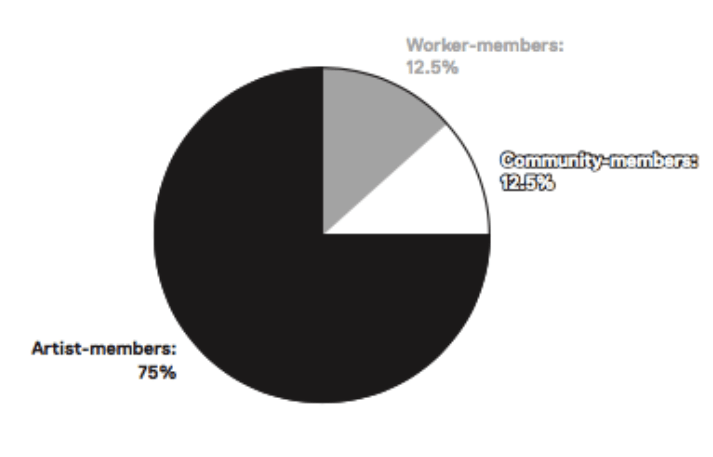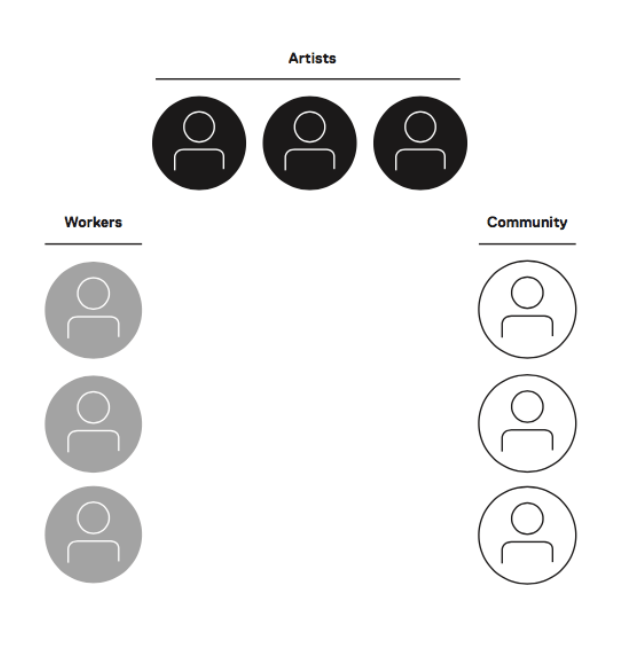by Austin Robey
January 13, 2020
Background
At Ampled, I’ve led the process of researching the necessary steps and considerations for becoming a cooperative. Starting the process was intimidating. While there are endless blog posts and videos explaining how to start startups, almost none of the material is applicable to starting a co-op.
We don’t have a team like a traditional startup. We have people with varying levels of commitment ranging from full time dedication, developers committing nights and weekends, and an orbit of advisors and mentors – all unified around our mission of making music more equitable for artists. Very few of us have been a member of any cooperative. Some of us have started companies before, but none of us have started a co-op.
Early on, I reflexively wanted to retain a co-op focused lawyer as quickly as possible to help guide us through this process. However, we ended up delaying an engagement with a lawyer for several months. This was partially due to us wanting to prioritize dedicating our early resources towards building our product, but also because we wanted more time to consider some important questions that would inform the organization’s structure. In that time, over the course of several months, we went through several iterations of how ownership & governance at Ampled would be designed.
Questions To Answer
The goal during this time was to reach a fairly articulated plan based on our own research and get to the point where we weren’t asking lawyers basic questions. We hoped to be able to communicate a fairly mature set of instructions to relay to lawyers.
Here are some of the questions and considerations we discussed that informed Ampled’s ownership and governance structure.
Note: We expect some of the answers to these questions to evolve over time. This is a reflection of Ampled’s ownership design as of the time of this article being posted.
1. What Does Ownership Mean?
This is more of a conceptual question to get everyone on the same page. What does ownership look like and what does it mean?
Many people ask a reasonable question: “What does ownership get me?” Normally, with tech startups, ownership is a slice of the pie which represents a lottery ticket for the possibility of an exit/ liquidity event.
However, conceptualizing ownership by percentage isn’t really applicable for us. We started by saying that our goal was not an acquisition or an exit. And if we’re not selling equity to investors, we may never have to determine the valuation of the platform. For us, we decided that ownership meant one share and one vote per person. A share is not something that is transferable or holds speculative value. It represents a share of profits and a voice in how the co-op does business.
One helpful reference for this question was reading this interview of Stocksy.
2. Are There Different Classes of Ownership?
With tech-enabled cooperative platforms, there may be a need for designing ownership around multiple classes of stakeholders. We decided to create three classes of membership. Then for each class, we decided what it takes to qualify as a member, how profit is shared, and how decisions are made.
Our classes of ownership:
-
Artist-owners
-
Worker-owners
-
Community-owners
3. What Is The Threshold To Become A Member For Each Class?
With each class of ownership, we drafted out a threshold of what it would take to qualify to become a member. Note: as our community and usership grows, we are likely to update these. For us, these answers are simply a benchmark way of thinking about this.
Artist-owners: we decided that to become eligible to be an Artist-owner, an individual would have to be an owner of an artist page on Ampled that has received $100 or more in support, and who has created at least 5 posts.
These guidelines were drafted with the idea of making sure we have an ownership base that is engaged and using the platform. When we have elections, we want to make sure people actually care and vote. The $100 support threshold serves as a fiscal contribution to the platform and also serves to make sure artists don’t sign up, abandon the platform, and get ongoing benefits of ownership.
However, each artist page may be a band with a range of numbers of members. We figured that some members of an artist page may not be as active as their other band members, so we included a minimum number of posts each band member would need to make to become a member.
Worker-owners: we decided that to become eligible to be a Worker-owner, an individual would have to have regularly contributed labor to Ampled for at least six months.
This mimics what we’ve seen organizations like Equal Exchange do. It seems reasonable to have a time requirement (similar to equity vesting in a traditional startup).
Community-owners: Based on feedback from music supporters that expressed interested in participating in the co-op, we decided that to become eligible to be a Community-owner, an individual would just need to pay a $25 fee. This would function similarly to a $25 REI membership, and for us is a way to allow people to support the organization and get involved.
4. How Are Profits Distributed?
You’ll want to make a decision on how profits should be distributed among each group. We landed at this distribution:
-
Artist-owners: 75%
-
Worker-owners: 12.5%
-
Community-owners: 12.5%

The reason for this distribution considers the following:
-
We wanted the artists to be the receive a large majority of profits
-
We wanted the profit sharing percentage for workers to be low enough to not eat into the artist profits, but high enough to be exciting in the event of a surplus.
-
We wanted all members to have some level of profit sharing. Based on feedback, we wanted to include non-artist and non-worker community members to have skin in the game with profit sharing. Having rights to profit sharing helps answer the question of “What does ownership get me?” We assume that the class of community-owners will have the highest number of individuals and will therefore be the smallest profit share per person.
5. How Are Profits Within Each Class Calculated?
This is also referred to as a “patronage dividend formula”. Here’s how we chose to address this question:
Artist-owners: Surpluses available for allocation are paid to active Artist-owners pro rata based on the amount of total support received by the particular active Artist-Owner through Ampled.
Worker-owners: Surpluses available for allocation are paid to active Worker-Owner. This is determined in any manner that the Board determines to be fair and equitable, in consideration of both the amount of time worked towards Ampled and by the value of contribution.
Community-owners: Surpluses available for allocation are paid to Community-Owner and distributed equally amongst each Community-Owner. If the Board determines that the amount of surplus allocation to Community-Owner is too small to justify the administrative cost of making patronage refunds, net income for Community-Owners may be re-invested in the Cooperative to expand activities that benefit Ampled’s mission.
6. What Is The Composition Of The Board of Directors?
For our board of directors, we chose to have a 9 seat board. With 3 representative seats elected from each class of ownership. We felt like the 3 seats for “Community-owners” gave us the ability to get some seasoned and experienced business or music brass on the board. We also have a separate, non-voting advisory board.

7. Who’s Making Decisions?
Maybe this is helpful in the early stages, or maybe you’re fine with mind-melding with your small team. It may be worth looking into how you envision decisions being made hierarchically. Although I’m glad we took the time to make this chart, it hasn’t been particularly useful yet. However, having an early version like this will be useful once the organization grows.

8. Can Someone Be A Member Of Multiple Ownership Classes?
We said that, yes, someone can be a member of multiple ownership classes, but may only vote as one particular class of member.
9. Other Governance Questions
It’s important to remember that bylaws can change and be amended. These questions are important to consider, but aren’t the decisions that are worth getting hung up on in the beginning. These include:
-
How often do board meetings happen?
-
What are the board responsibilities?
-
When is ownership terminated?
-
How are proposals considered?
-
How are bylaws changed?
-
How many members are needed for a quorum?
10. How Do You Compensate Sweat Equity?
I’m leaving this question last because it is one that we do not have the answer to yet. With varying levels of risk, time, and dedication among our contributors, it’s tough to figure out the best way to compensate for this. In lieu of traditional equity-based incentives that traditional startups use, we’ll have to get creative. Once we do go through this process, I can follow up with another post on this. If you have suggestions, feel free to leave them in the comments.
